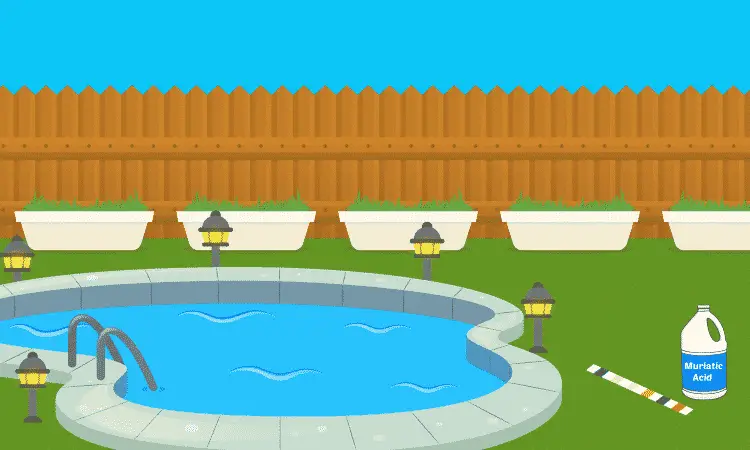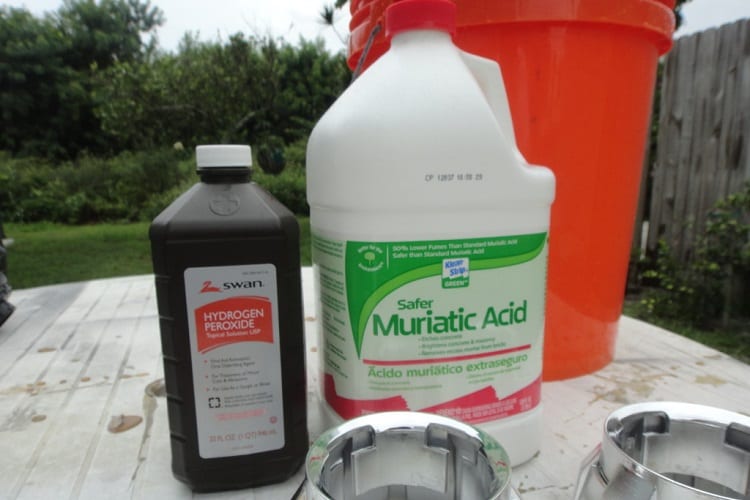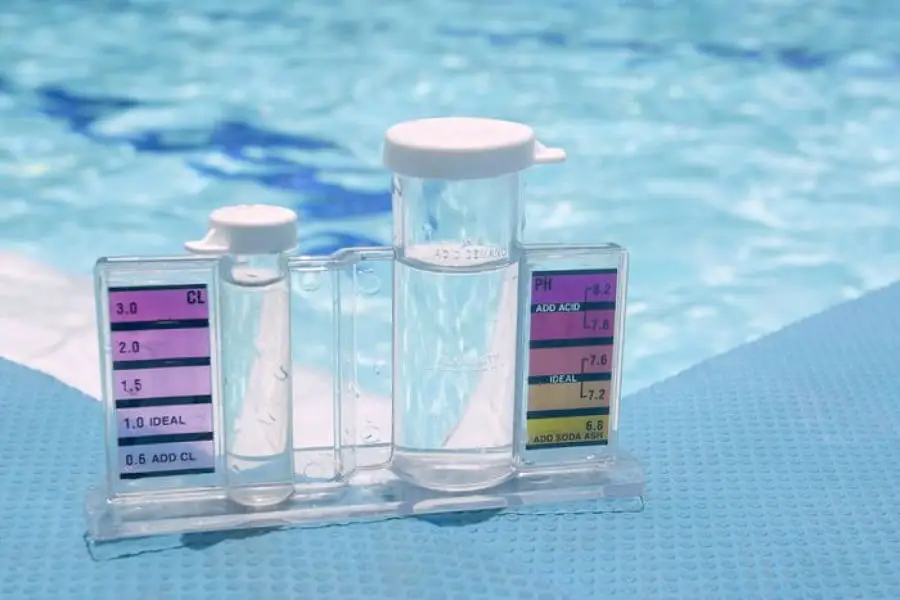If you own a pool, you probably are aware of the importance of pool maintenance.
A lot goes into keeping up the pool in its best condition. You have to regularly check its plumbing system, watch out for minor repairs, maintain water and chemical balance, and so on. Among common pool maintenance chores is the checking of the pool’s pH level.
Note that the ideal pH for pool water is 7.4. Having an optimum pH level keeps both the pool and swimmers safe from possible harm. Research shows that a too-high pH level can be the cause of skin irritation among swimmers and corrode away various pool parts.
Many factors can lead to a jump in the pool’s pH level such as adding too much chemicals or disinfectants into the pool.
In such scenarios, you should consider the use of muriatic acid as it helps dial down the alkaline level in your pool and brings it back to the desired degree. However, like any other toxic chemical solution, muriatic acid can be harmful if mishandled.
To prevent any life-threatening hazard from taking place (to you or to your pet or family), we recommend you give this article a read.
Here we discuss everything you should know about muriatic acid and pool from how to safely add the acid to your pool to how much you should use it to other crucial details, so without any further ado, let’s begin!
If you’d like to see a graphical breakdown of the adding muriatic acid to your pool, we got you covered:

Share this Image On Your Site
Contents
Is Muriatic Acid Safe for Swimming Pools?

Muriatic acid is a powerful chemical solution that is formed from the combination of hydrochloric acid (HCI) and water.
The pungent substance is highly acidic and corrosive. However, it has many commercial and household uses including cleaning the pool of its contaminants and adjusting the pool’s alkalinity level.
Given its uses, muriatic acid is ideal for keeping your pool water clean and healthy. However, it’s essential to always add the right amount of muriatic acid to your pool. If added too much, the toxic solution can cause rashes and skin/eye irritation.
Also, too much muriatic acid reduces the pH level and this can corrode metals in your pool including bolts, screws, railings, ladders, etc.
But don’t worry if you end up mixing in muriatic acid more than its requirement. Balance it out by adding in soda ash or sodium carbonate. This will help bring back the pH to the desired level.
How Often Should I Add Muriatic Acid to my Pool?

When it comes to using muriatic acid for your pool, its quantity is everything. You can’t add in too much or too little muriatic acid.
You have to be careful about how much you use the product. You should add muriatic acid when the pH level is high.
It takes time for the water to change its pH, so before you think of adding some more of muriatic acid, wait for a couple of hours. If the acidity level remains the same after 3 – 4 hours, add a bit more of the acid.
How Do I Add Muriatic Acid to my Pool?
Here’s a step-by-step guide on how to lower your pool’s alkalinity level and eliminate contaminants using muriatic acid.
1. Test Your Pool Water
The first step is to always test your pool water before you pour chemicals or dive in for a good swim. To test your pool water correctly, make sure you have a testing kit (testing strips, liquid or digital testing kits) at home.
You need to be clear about how many gallons of water your pool holds along with its current pH level. It’s best to use a digital testing kit as it minimizes user error and gives accurate results.
With the aid of calculator apps, you can observe and maintain your pool chemistry before adding muriatic acid to the pool. Remember that the ideal pool water reading ranges from 7.2 – 7.8. Anything higher than that calls for the acid.
2. Wear Protective Gear
If you find the alkalinity level of your pool water too high, incorporate muriatic acid into it.
But before you do that, it’s extremely important that you wear protective gear first. Even minimal exposure to the skin can cause severe burns and scarring, so wearing protective gear is vital.
Opt for clothing that fully covers your legs and arms. To be on the safe side, put on a chemical-resistant apron. Wear durable and acid-resistant gloves.
The labels on the gloves can help you understand what gloves will be ideal for the job. Also, invest in a pair of good-quality goggles to protect your eyes from any potential splish-splash. You should also cover your head in a way that protects your ears.
If, by mistake, you spill the acid on your skin, place cold water on the affected area right away. Doing so will alleviate the potential effects of the acid.
3. Dilute the Acid
This is another most important step in safely adding muriatic acid to your pool. If you add the acid without diluting it first, the solution will be far too strong and dangerous. To make it less potent, you should blend the acid in a bucket of water.
The amount of acid should be about 10% of the water in the bucket. Your aim should be achieving a minimum of 10:1 dilution ration.
This means for half a 5-gallon bucket (2.5 gallons), you should combine one quart of acid. In case you need more water than the bucket can hold, repeat the process, or use another bucket.
Muriatic acid is thick and it tends to settle at the bottom of the bucket. This is where diluting becomes so essential. Using a plastic stirrer, mix the water-and-acid solution until everything is well combined. Keep in mind, it’s best to use clean water as opposed to the pool water for dilution.
4. Turn On/Off Your Pump
There is considerable debate over whether to turn on or off your pump when adding the acid to your pool.
The reason behind keeping the pump running is that it helps the muriatic acid dissolves rapidly in the pool water or else it may sit on your pool floor and corrode away the components.
On the other hand, it’s advised to keep the pump shut because this way the chemicals circulate better and have greater effects on the pool’s pH level. As to whether turn on or off the pump is your call. Weigh in the pros and cons of both the options before you choose either.
5. Add the Acid
This is the most important step of all. Slowly and gently pour muriatic acid into the pool. Be patient and careful while you’re adding the solution to the pool water. Once you’re done pouring the solution, check the bucket for any sign of remaining acid.
Often, the acid settles down and sticks to the bottom. If met with this situation, rinse the bucket with pool water thoroughly. Do not pour the acid in a skimmer or gutter as it can have hazardous outcomes.
6. Wait for Half an Hour or So
Don’t even think of getting in the pool until the pH has dialed down to the right level. Keep in mind that muriatic acid takes time to do its work, so wait for at least 30 minutes.
If you choose to keep the pump off, brush your pool floor to avoid any plausible damage. Afterward, test the water again for its alkaline level. Consider repeating this process to get the level right.
Can You Use a Muriatic Acid in Vinyl Pool?

Adding muriatic acid in large doses to tweak the pH level can deteriorate the vinyl liners of your pool.
This happens because the acid is not properly mixed with the pool water. To avoid the chemical attack on your vinyl patterns, it’s better to use cyanuric acid rather than muriatic acid for adjusting pH levels.
Conclusion
Now that you know how to safely add muriatic acid to your pool, you can use the chemical solution at any time you witness the pH and alkaline levels of your pool escalated.
You can also use the acid to remove stains, clean tiles, or to get rid of any mold and algae at the end of a particular season.



